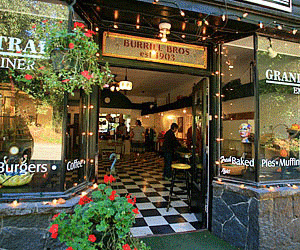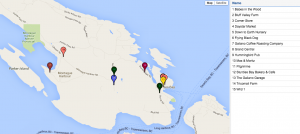Weekly objectives and achievements, upcoming objectives
Our objectives this week have been to schedule interviews with as many of the producers and people involved in food production on Galiano Island as possible during our visit next weekend. To do this efficiently, we created a list of contacts to organize them into categories, including food trucks, restaurants, farms, value-added goods and grocery stores. These were then delegated for calling to increase the maximum coverage and to prevent overlap, and increase efficiency. We created a Google Calendar to organize the interview time, which gives a clear visual of our schedule, thus allowing us to account for travel time in between interviews.
So far we have made good progress getting in touch with our list of contacts, however there have been several who are unsure of their upcoming plans, or may not be on Galiano Island during the weekend that we will be visiting. This means we will have to be flexible, which affects the efficiency of our routes as we cannot visit all the vendors in the same area in the same time frame. As in the podcast we listened to this week, sometimes even the best laid plans do not work out as you have intended, so hopefully our scheduling comes to fruition. Unlike the geese, however, we do not believe that complete freedom is a wise option for us because we only have one opportunity to complete our objectives. We aim to fill up our time on the island with as many in-person interviews as the time allows, and the only way to do so is to plan in advance and form a tight schedule.
Another unplanned change we made was to email some of the producers and proprietors in addition to calling. We had thought that contacting people by phone was more personal, as well as more direct in that we can obtain an immediate answer. However, not all of our contacts were able to be reached by phone and it was difficult to explain the extent of our project over the phone, an email was both informative and allowed the recipient to respond at their convenience.
Additionally, we realized that it would be advantageous to make our schedule based on not only time, but geographical location as well. In the midst of the complicated process of mapping out the locations of all of our contacts, we stumbled across a map provided by the Galiano Island Tourism website that already had this information. This simplified the process, and enabled us to quickly plan several stops within the same vicinity.
Some issues that arose, which slowed the planning process is that some producers do not live on Galiano Island, and thus may not be available on the weekend that we are visiting. A remedy for this is to set up a phone or email interview to be conducted following our stay. The other is that not everyone is available in a sequential order based on our map and schedule. Again, this is reminiscent of the foie-gras geese: despite Dan’s every effort to achieve a perfect world for his geese in which they would have a happy life and produce delicious, cruelty-free foie gras, it did not have the expected results. We are, of course, hoping that our trip will be more productive, but it is true that life has all kinds of funny twists, turns and curve balls, and we need to be prepared for both the predictable and the completely unforeseen.
Our upcoming objectives are possibly the most relevant and important ones in our project. Next weekend we will be heading to Galiano Island to conduct our interviews, and the information we gain from these interviews will form the basis of the index of agricultural products. Our objectives on Galiano Island are to conduct the scheduled interviews, aid the Galiano Food Program in events happening during that weekend, and to weed the community garden. In order to achieve these objectives, the most important strategy is time management. We will need to strictly follow the schedule we have created beforehand, which may mean limited time to sightsee on the island. Another upcoming objective is to add to our preliminary list of interview questions and finalize which questions will be used in the interviews conducted at the island. We can achieve this by discussing them with our TA to ensure they are appropriate and obtain feedback for improvement. We will also assign the roles of interviewers or note takers for each group member for every consensual interview.
Significance
As our project develops and our trip to the island comes closer at hand, we have begun to face new challenges in coordinating amongst ourselves in regards to preparing for the trip. A problem occurred this past week, when it came time to book our accommodations and ferry tickets. Confusion began to surface over where we were staying, what our budget was, and who would be purchasing which items. Although we were aware that we would be reimbursed for the majority of our expenses, we knew that it was important to keep track of who was reserving what, in order to prevent double-booking and to ensure that all of our receipts could be easily accessed. Giving each member of the group one specific job or part to keep track of helped us stay as organized as possible for counting funds used; for example, Nic is taking care of all the fuel costs for the van as it is simpler than everyone splitting those costs and then reimbursing each individual contribution.
This problem was confusing for everyone, especially as many of us were uncertain about our personal financial limits that we could contribute at the moment, knowing that it could take some time before we were fully reimbursed. And while it may seem trivial, it caused us to see that the broader issue at hand is being able to be flexible and understanding of individual and group needs. Close organization and close communication within the entire group was important to be certain that everything is complete, and that nothing is done more than once. In order to solve the problem, it was important take a step back and listen to everyone’s opinions and issues with how the problem was initially being addressed. Once everyone was involved in the conversation, everyone got on the same page, and individual tasks were assigned and easily completed.
Working to be more flexible around each other’s budgets and availability to communicate with those helping us to plan our stay, we were able to address the problem so that the burden did not fall on to just one team member’s shoulders alone. Being more understanding of individual and group constraints helped us all to formulate a solution to our problem while still respecting each other and our needs. Upon finally dividing everything up and organizing our list of objectives, we were able to accomplish all of our travel plans on time and made the alterations that we had to, whilst staying organized and maintaining a simplistic approach to our trip planning. Although they were not as extreme as Dan’s in the podcast, they will still be helpful in running this trip smoothly.
References
Barber, D. (2011). Poultry Slam 2011 [Podcast]. Chicago, IL: This American Life.


